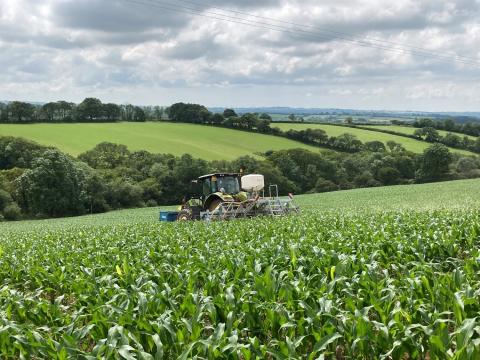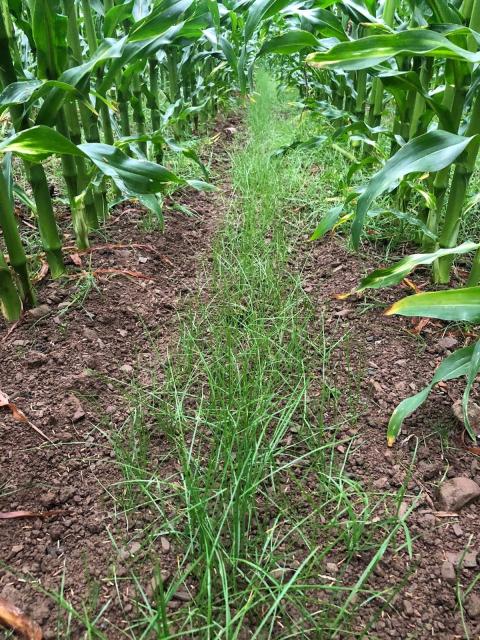Arnolds Hill Farm Project Introduction: Undersowing maize for environmental and economic benefit
Site: Arnolds Hill Farm, Slebech, Haverfordwest
Technical Officer: Delana Davies
Project Title: Undersowing maize for environmental and economic benefit
Introduction to project
Climate change is delivering more winter heavy rainfall incidences that river monitoring has indicated is accompanied by spikes in river phosphate levels, which has been attributed to soil run-off. Leaving maize stubbles bare over winter is therefore not sustainable, but planning to establish a crop or cover after maize harvest can be problematic because of autumn soil conditions and late sowing.
In Denmark, thousands of hectares of maize are now undersown with grass seed and extensive trial work there has provided guidelines to ensuring good establishment.
What are the benefits?
- Reduces soil erosion
- Builds fertility
- Builds organic matter
- Retains soil nutrients (+/- 40kg/ha N and K)
- Enhances soil structure
- Easier preparation of spring seedbeds
- Cross compliance good practice
- Provides winter/spring grazing opportunity (>1,500 ewe grazing days/ha or >300 heifer grazing days)
Trials in Herefordshire carried out by the Wye and Usk Foundation and Field Options have effectively managed to establish grass by undersowing into the maize crop without a significant effect on the performance of the maize crop. Soil losses have been reduced and winter cover of up to 4 tonnes dry matter/hectare produced; this can be incorporated as green manure or provides useful early spring grazing.
Establishing the undersown cover crop
The target period for sowing cover crops into maize is from one week after the last herbicide is applied through to the stage when the crop is thigh high in early July. The maize crop should be between the four leaf and ten leaf stage.
Early work involves either broadcasting the grass seed onto the ground or broadcasting and harrowing it in with a wire-tined rake; this can be effective when rain follows but is much less reliable when dry. Initial drilling work was carried out using a modified drill to deliver grass strips between the rows of maize, but purpose-built drills are now being manufactured.
What will be done
A 5 hectare (ha) field situated on a slope and sown with Augustus maize has been chosen as being likely to suffer from soil erosion if left uncropped over winter. The overall aim will be to establish a root network by harvest time to stabilise the soil and carry traffic, reducing any possible run-off and erosion at the time of harvest and over winter.
Four trial plot areas will be established by undersowing into the standing maize crop at the end of June/early July using a Zocon tine drill:
Plot 1 – Italian ryegrass (IRG) blend sown at 7kg/ac (17.3kg/ha). IRG is chosen as it is vigorous and economical to use as a short rotation crop.
Plot 2 - Straight tetraploid perennial ryegrass sown at 8kg/ac (19.8kg/ha). This has the potential to graze better quality grass if left through to the next season (leafier and will head later). It will last longer than IRG and this trial will investigate how well it competes under the maize canopy.
Plot 3 - Italian ryegrass and winter vetch sown at 12kg/ac (29.6kg/ha). With the vetch being a legume, it has the ability to fix nitrogen for the following crop. It is also a high protein plant, therefore, either grazed or cut, it will boost the protein content for livestock.
Plot 4 – IRG and Berseem clover sown at 8kg/ac (19.8kg/ha). This option provides for rapid biomass cover and the ability to quickly fix nitrogen. The clover is an annual therefore can be grazed out/cut out or left to keep fixing nitrogen. Protein quality of the grazed or silage grass is again boosted by the clover. Although this clover is not very frost tolerant, this can represent a bonus when direct drilling the following spring crop, as most of the canopy will be gone by this time.
Following the maize harvest, anticipated in late September, grass cover will be allowed to bulk up and grazed by tack sheep from November onwards with the number of grazing days achieved recorded.
Project update
Drilling the grass cover crop on 2 July
Grass establishment on 30 July


